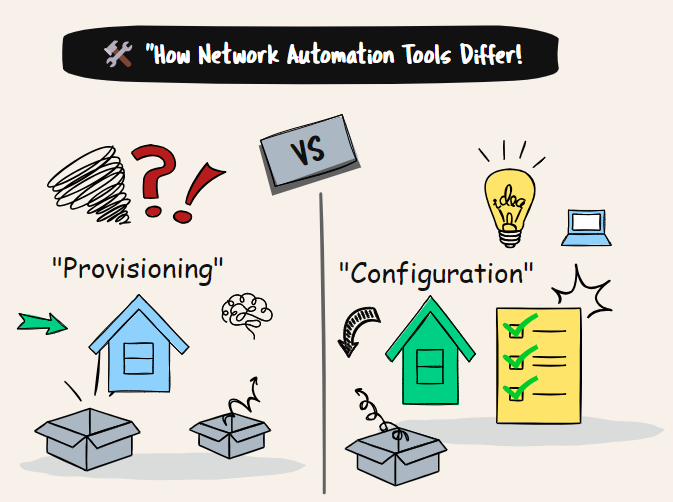- Netomate
- Posts
- Understanding Key Differences in Infrastructure and Network Automation Tools
Understanding Key Differences in Infrastructure and Network Automation Tools
A Simple Guide to How These Tools Work and What Makes Them Unique
As a network Engineer, we need to know some of the Major Architectural and Conceptual Differences Between Tools.

When it comes to automation tools for networks and infrastructure, they aren't all built the same way.
Here are some important differences you should know — explained in a way that’s easy to understand:
1. Building vs. Setting Up Infrastructure
Infrastructure provisioning is like building the house — setting up walls, roofs, windows, and doors (things like servers, network connections, and databases).
Configuration management is like setting up the inside of the house — adding beds, lights, and furniture (installing and configuring the right software).
Provisioning happens on Day 0 (building), and configuration happens on Day 1 (setting things up properly).
Thanks for reading Automation! This post is public so feel free to share it.
2. Agent-Based vs. Agentless Tools
Agent-based tools need a little helper (software) installed on each device to manage it.
Agentless tools don’t need any helper installed; they connect directly.
In networking, agentless tools are often better because many devices don’t allow installing extra software.
3. Centralized vs. Decentralized Control
Centralized = one big "boss" server tells all devices what to do.
Decentralized = devices manage themselves or work with each other without a central boss.
4. Special Language vs. Common Language
Some tools use their own special language (DSL), and you have to learn it to use the tool.
Other tools use common formats like YAML, making it easier because many people already know it.
5. Declarative vs. Imperative Approaches
Declarative = you say what you want ("I want a red living room") and the system figures out how to do it.
Imperative = you tell it step-by-step ("First paint the wall red, then bring in a big sofa").
6. Extending Tools with Programming
Many tools let you add extra features using common languages like Python or Go — kind of like upgrading your house with smart gadgets.
7. Push, Pull, and Event-Driven Actions
Push model = you send instructions to the devices.
Pull model = devices ask for new instructions themselves.
Event-driven = devices act when something specific happens (like turning on lights when someone rings the doorbell).
8. Mutable vs. Immutable Infrastructure
Mutable = you change things in the house while living in it (like repainting while living there).
Immutable = if you want changes, you build a brand-new house and move in.
9. Managing the "State" of Infrastructure
Some tools don’t remember what was changed — you have to check manually.
Other tools keep track of everything they built and know when something needs to be rebuilt or fixed.
Smiles:)
Anurudh
Reply